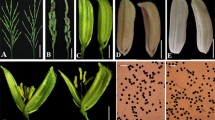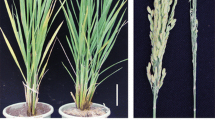Abstract
The seedlings of indica rice cultivar Dular are susceptible to chlorosis under low temperature conditions. Our previous studies indicated that low temperature-induced seedling chlorosis is controlled by a recessive gene, located between SSR markers RM257 and RM242, on the long arm of chromosome 9. We temporarily named the gene cisc(t). Using a large F2 population derived from a cross between Dular and the japonica cultivar Lemont, which displays a normal green color at low temperatures, cisc(t) was fine mapped to within a 12-kb interval. There is only one annotated gene in this interval, which encodes a pentatricopeptide repeat (PPR) protein. Sequence analysis indicated that 8 bases were deleted at the 60th base in the Dular allele, resulting in a frame-shift mutation and loss of function of the gene. This is consistent with the chlorosis mutant phenotype of Dular. In addition, previous studies have shown that many chlorosis mutants of seedlings are related to PPR proteins. Hence, we presume that the PPR gene is the candidate for cisc(t).
Similar content being viewed by others
References
Tomoko A, Tomoki M, Shigeko S, et al. Chlorophyll-deficient mutants of rice demonstrated the deletion of a DNA fragment by heavy-ion irradiation. J Radiat Res, 2002, 43: 157–161
Iwata N, Omura T, Satoh H. Linkage studies in rice (Oryza sativa L.) on some mutants for physiological leaf spots. Fac Agr Kyushu Univ, 1978, 22: 243–251
Ji D F, Xu F H. The cytoplasmic inheritance of Chlorophyll deficiency in cotton (in Chinese). Hereditas (Beijing), 1979, 1: 15–19
Si L T, Zhang L, Jing G L, et al. Primary genetic study of albino mutation of Chinese cabbage (in Chinese). Hereditas (Beijing), 1992, 14: 12–14
Li G Q, Li M, Wu D W. The induced mutation of chlorophyll deletion of soybean through radiation and its genetic analysis (in Chinese). J Jilin Agric Univ, 1987, 9: 46–51
Schmitz-Linneweber C, Williams-Carrier R E, Williams-Voelker P M, et al. A pentatricopeptide repeat protein facilitates the trans-splicing of the maize chloroplast rps12 pre-mRNA. Plant Cell, 2006, 18: 2650–2663
Guevara-Garcia A, Román C S, Arroyo Analilia, et al. Characterization of the Arabidopsis clb6 mutant illustrates the importance of posttranscriptional regulation of the methyl-D-erythritol 4-phosphate pathway. Plant Cell, 2005, 17: 628–643
Jung K H, Junghe H, Choong-Hwan R, et a1. Characterization of a rice chlorophyll-deficient mutant using the T-DNA gene-trap system. Plant Cell Physiol, 2003, 44: 463–472
Chen T, Zhang Y D, Zhao L, et al. Fine mapping and candidate gene analysis of a green-revertible albino gene gra(t) in rice. J Genet Genomics, 2009, 36: 117–123
Shu Q Y, Wu D X, Xia Y W, et al. Study on greenism characteristics of greenable albino mutation line W25 of rice (Oryza sativa L.) (in Chinese). J Zhejiang Agric Univ, 1996, 22: 219–220
Wu D X, Shu Q Y, Xia Y W, et al. 60Cogamma-ray induced temperature-regulatory leaf color albino mutated gene expression mutant line in rice (Oryza sativa L.) (in Chinese). Sci Agric Sin, 1997, 30: 95–96
Chuong P V, Omura T. Studies on the chlorosis expressed under low temperature condition in rice, Oryza sativa L. Bull Inst Trop Agr Kyushu Univ, 1982, 5: 1–58
Xia J C, Wang Y P, Ma B T. Ultrastructure and gene mapping of the albino mutant al12 in rice (Oryza sativa L.). Acta Genet Sin, 2006, 33: 1112–1119
Lan T, Liang K J, Chen Z W, et al. Genetic analysis and gene mapping of cold-induced seedling chlorosis in rice (in Chinese). Hereditas (Beijing), 2007, 29: 1121–1125
Lan T, Zhen J, Wu W R, et al. Construction of a microsatellite linkage map in a DH population (in Chinese). Hereditas (Beijing), 2003, 25: 557–562
Lincoln S, Daly M, Lander E. Constructing Genetics Maps With MAPMAKER/EXP 3.0. Whitehead Institute Technical Report. Cambridge, MA, 1992
Zhan Q C, Zhu K Y, Chen Z W, et al. Mapping QTLs controlling seedling cold tolerance in Rice using F2 population (in Chinese). J Hunan Agric Univ (Nat Sci), 2004, 30: 303–306
Chateigner-Boutin A L, Ramos-Vega M, Guevara-García A, et al. CLB19, a pentatricopeptide repeat protein required for editing of ropA and clpP chloroplast transcripts. Plant J, 2008, 56: 590–602
Yu Q B, Jiang Y, Chong K, et al. AtECB2, a pentatricopeptide repeat protein, is required for chloroplast transcript accD RNA editing and early chloroplast biogenesis in Arabidopsis thaliana. Plant J, 2009, 59: 1011–1023
Gothandam K M, Kim E S, Cho H, et al. OsPPR1, a pentatricopeptide repeat protein of rice is essential for the chloroplast biogenesis. Plant Mol Biol, 2005, 58: 421–433
Beick S, Schmitz-Linneweber C, Williams-Carrier R, et al. The pentatricopeptide repeat protein PPR5 stabilizes a specific tRNA precursor in maize chloroplasts. Mol Cell Biol, 2008, 28: 5337–5347
Author information
Authors and Affiliations
Corresponding author
About this article
Cite this article
Lan, T., Wang, B., Ling, Q. et al. Fine mapping of cisc(t), a gene for cold-induced seedling chlorosis, and identification of its candidate in rice. Chin. Sci. Bull. 55, 3149–3153 (2010). https://doi.org/10.1007/s11434-010-4041-3
Received:
Accepted:
Published:
Issue Date:
DOI: https://doi.org/10.1007/s11434-010-4041-3




